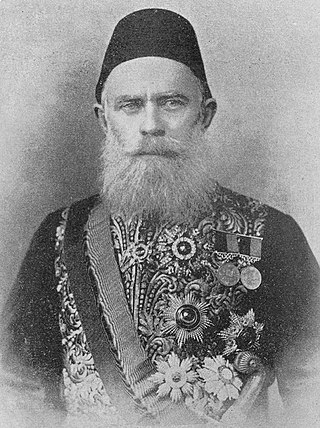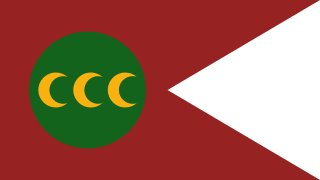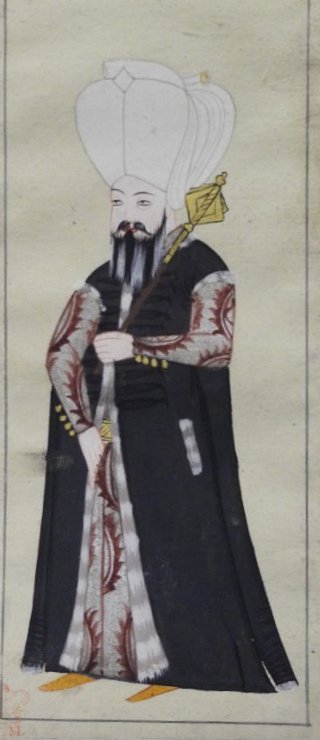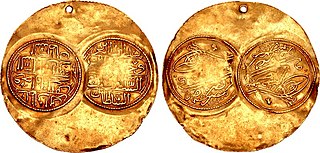Related Research Articles

The administrative divisions of the Ottoman Empire were administrative divisions of the state organisation of the Ottoman Empire. Outside this system were various types of vassal and tributary states.

A divan or diwan was a high government ministry in various Islamic states, or its chief official.

Sardar, also spelled as Sardaar, is a title of royalty and nobility that was originally used to denote princes, noblemen, chiefs, kings and other aristocrats. It has also been used to denote a chief or leader of a tribe or group. It is used as a Persian synonym of the title Emir of Arabic origin.

Ahmed Cevdet Pasha or Jevdet Pasha in English was an Ottoman scholar, intellectual, bureaucrat, administrator, and historian who was a prominent figure in the Tanzimat reforms of the Ottoman Empire. He was the head of the Mecelle commission that codified Islamic law for the first time in response to the Westernization of law. He is often regarded as a pioneer in the codification of a civil law based on the European legal system. The Mecelle remained intact in several modern Arab states in the early and mid-20th-century. In addition to Turkish, he was proficient in Arabic, Persian, French and Bulgarian. He wrote numerous books on history, law, grammar, linguistics, logic and astronomy.

The history of the Ottoman Empire in the 18th century has classically been described as one of stagnation and reform. In analogy with 18th-century France, it is also known as the Ancien Régime or Old Regime, contrasting with the "New Regime" of the Nizam-i Cedid and Tanzimat in the 19th century.

Cezayirli Gazi Hasan Pasha or Hasan Pasha of Algiers was an Ottoman Grand Admiral (1770–90), Grand Vizier (1790), and general in the late 18th century.

Kaymakam, also known by many other romanizations, was a title used by various officials of the Ottoman Empire, including acting grand viziers, governors of provincial sanjaks, and administrators of district kazas. The title has been retained and is sometimes used without translation for provincial or subdistrict governors in various Ottoman successor states, including the Republic of Turkey, Kuwait, Iraq, and Lebanon.

Beylerbey was a high rank in the western Islamic world in the late Middle Ages and early modern period, from the Anatolian Seljuks and the Ilkhanids to Safavid Empire and the Ottoman Empire. Initially designating a commander-in-chief, it eventually came to be held by senior provincial governors. In Ottoman usage, where the rank survived the longest, it designated the governors-general of some of the largest and most important provinces, although in later centuries it became devalued into a mere honorific title. The title is originally Turkic and its equivalents in Arabic were amir al-umara, and in Persian, mir-i miran.

The Beylik of Dulkadir was one of the Anatolian beyliks established by the Turkoman clans Bayat, Afshar, and Begdili after the decline of Seljuk Sultanate of Rûm.

Mohammad Khodabanda, was the fourth Safavid shah of Iran from 1578 until his overthrow in 1587 by his son Abbas I. Khodabanda had succeeded his brother, Ismail II. Khodabanda was the son of Shah Tahmasp I by a Turcoman mother, Sultanum Begum Mawsillu, and grandson of Ismail I, founder of the Safavid dynasty.

Çavuş, also anglicized Chaush and Chiaus was an Ottoman title used for two separate soldier professions, both acting as messengers although differing in levels. It was a rank below agha and kethüda, in units such as the Janissaries and Sipahi, and was also a term for members of the specialized unit of çavuşān consisting of combined cavalry and infantry serving the Imperial Council. The leaders of the council's çavuş were titled çavuşbaşı / چاوش باشی. The çavuşbaşı was an assistant to the Grand Vizier, dealing with security matters, accompanying ambassadors visiting the Grand Vizier, and also carried out the first examination of petitions submitted to the council, and led council meetings when the Grand Vizier was not present. The title has its origin in Uyghur use, where it was the title of ambassadors, and then entered Seljuq use for Byzantine imperial messengers, and Persian and Arabic use for various court attendants.

Afshar is a tribe of Oghuz Turkic origin, that split into several groups in Iran, Turkey and Afghanistan.
The Surname Law of the Republic of Turkey is a law adopted on 21 June 1934, requiring all citizens of Turkey to adopt the use of fixed, hereditary surnames. Prior to 1934, Turkish families in the major urban centres had names by which they were known locally, and were used in similar manner to a surname. The Surname Law of 1934 enforced the use of official surnames but also stipulated that citizens choose Turkish names. Until it was repealed in 2013, the eldest male was the head of household and Turkish law appointed him to choose the surname. However, in his absence, death, or mental incapacitation the wife would do so.
Pasha was a high rank in the Ottoman political and military system, typically granted to governors, generals, dignitaries, and others. Pasha was also one of the highest titles in the 20th-century Kingdom of Egypt and it was also used in Morocco in the 20th century, where it denoted a regional official or governor of a district.

Koca Mehmet Ragıp Pasha (1698–1763) was an Ottoman statesman who served as a civil servant before 1744 as the provincial governor of Egypt from 1744 to 1748 and Grand Vizier from 1757 to 1763. He was also known as a poet. His epithet Koca means "great" or "giant" in Turkish.
Ivaz Mehmed Pasha, also known as Hacı Ivaz Mehmed Pasha or Hacı Ivazzade Mehmed Pasha, was an 18th-century Ottoman grand vizier and provincial governor.
Cenaze Hasan Pasha was a short-term Ottoman grand vizier in 1789. His epithet Cenaze means "corpse" because he was ill when appointed to the post.

Izzet Mehmed Pasha was an Ottoman statesman who served as the Grand Vizier of the Ottoman Empire twice, first from 1774 to 1775, and second from 1781 to 1782.

Safed Sanjak was a sanjak (district) of Damascus Eyalet in 1517–1660, after which it became part of the Sidon Eyalet. The sanjak was centered in Safed and spanned the Galilee, Jabal Amil and the coastal cities of Acre and Tyre. The city of Safed was made up of Muslim and Jewish townspeople. At the same time the rest of the sanjak was populated by Sunni Muslims, Jewish peasants, Bedouin tribesmen, Shia Muslims/Mitwali, and Druze peasants.

Mehmed Rashid Pasha was an Ottoman statesman who served as the vali (governor) of Syria Vilayet in 1866–1871 and as minister of foreign affairs of the Ottoman government in 1873–1874 and 1875 until his death. Rashid Pasha was raised in Egypt where his father was an aide of the governor Muhammad Ali and was educated in Paris before joining government service in Istanbul in 1851. There he became a protege of the grand vizier Ali Pasha, a key figure in the empire-wide Tanzimat reforms. After the latter was reappointed grand vizier in 1866, Rashid Pasha was appointed governor of the Damascus-centered Syria Vilayet which extended from Tripoli and Hama in the north to Palestine and Transjordan in the south.